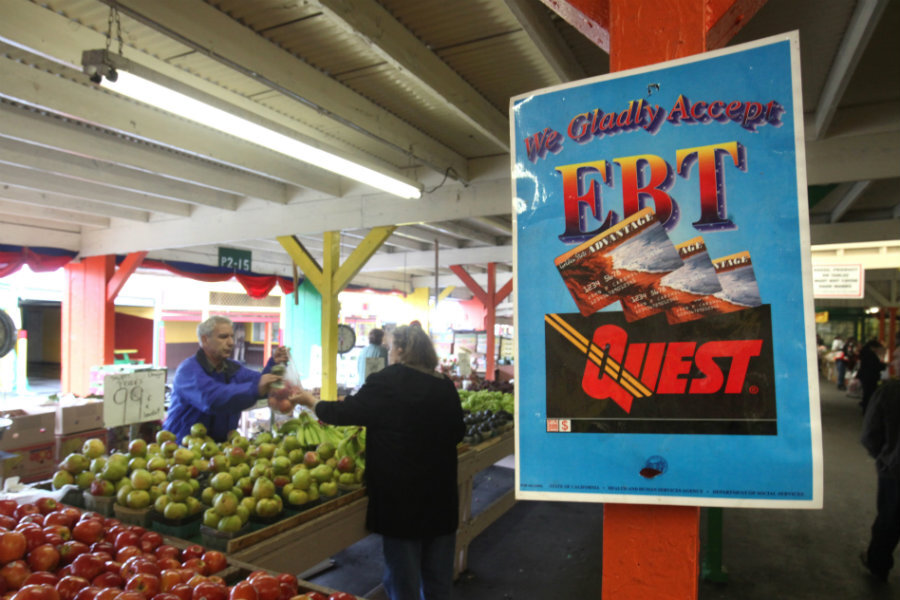Why SNAP benefits could be going digital
Loading...
Online shopping has long been a boon for most Americans, whether they hate the scrutinizing stares of fellow shoppers, the chaos of big stores, or simply can't get out the door. Soon, modifications to the federal food stamp program, SNAP, might make the benefits of online shopping available to some who could need it most: the many recipients who live in areas where there are fewer healthy grocery stores, known as "food deserts."
On Thursday, the Department of Agriculture began asking for companies to join a pilot project to allow SNAP recipients to purchase their groceries online. If successful after a two-year pilot period, the program may be expanded.
"We have an opportunity to be putting pressure on making sure that food stamps are a 21st century program," Gunnar Lovelace, a cofounder of the online healthy grocery store Thrive Market, told CNNMoney.
Thrive Market is just one of many healthy online food retailers that launched a petition this summer to allow SNAP beneficiaries to use their food stamps online. Other signers include meal kit service Blue Apron and meal replacement company Soylent. In total, more than 310,000 people signed the petition.
It is not yet clear whether Thrive Market will be one of the online retailers included in the pilot program, which is slated to begin next summer.
"We haven't run the campaign to make the USDA look bad, our goal is to be long-term partners in innovating," said Mr. Lovelace.
The proposal has also gotten support from legislators, as well, The Chicago Tribune reports. This week, Sen. Cory Booker (D) of New Jersey and California Representative Barbara Lee (D) wrote to Tom Vilsack, the Secretary of Agriculture, in support of speeding up the implementation of the pilot program.
"It would help us move toward a hunger-free and more nutritious America," they wrote. "Unfortunately, many of our governmental policies and programs have not kept pace with the dramatic improvement in healthy food access that technology offers."
The pilot program is expected to involve a handful of online retailers in up to three states.
Government officials expect the program to primarily benefit the disabled, the elderly, and others who have a difficult time leaving home. It could also help those who have little access to healthy food options. SNAP benefits will not include fees for delivery, however, limiting how many recipients might use an online program.
Although most food stamps are redeemed at grocery stores, many people in poorer neighborhoods have limited options when it comes to purchasing food. In 2012, for example, food equity researcher Mari Gallagher (who coined the term "food desert") found that in the Pullman and Roseland communities near Chicago, 85 to 87 percent of SNAP authorized food sellers did not provide enough nutritional variety in their food offerings, according to The Chicago Tribune.
The USDA is currently in the process of modifying the authorization requirements for retailers that accept SNAP benefits, attempting to promote ensure that more healthy food choices are available. However, the proposed rules might actually have the opposite effect, some critics say.
The 2014 Farm Bill increased the number of items that stores would be required to have in stock to qualify to accept SNAP: up from three items in each of the USDA's four staple food categories, to seven each. A more recent proposed change, however, would mean that stores would have to offer a total of 168 different items to qualify as a SNAP-authorized vendor, making it nearly impossible for many smaller stores to qualify, such as convenient stores, and thereby making SNAP benefits even harder to redeem in inner city neighborhoods.
Modernizing the SNAP benefit program to include online shopping might help fix that problem.
Regardless, some public health advocates are enthused about SNAP's pilot project.
"Many families of all economic levels are busy and don't have time to shop. This helps bring SNAP recipients more into the mainstream.... We're very excited about it," Ms. Gallagher told The Chicago Tribune.








